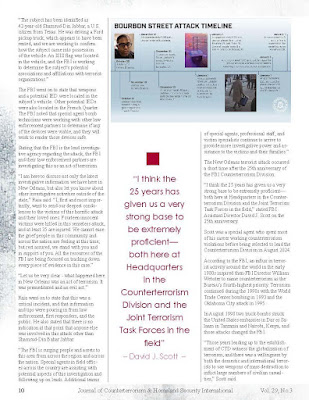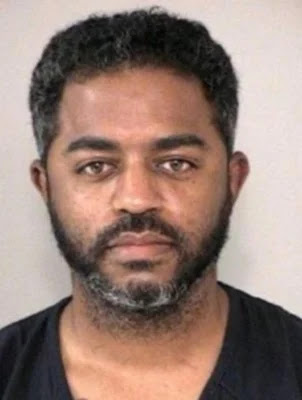Counterterrorism magazine published my piece on the FBI investigating the New Orleans terrorist attack as the FBI celebrates the 25th anniversary of their Counterterrorism Bureau.
You can read the magazine pages below or the below text:
The
FBI is Investigating the Terrorist Attack in New Orleans
As
the FBI’s Counterterrorism Division Turns 25
By Paul Davis
On January 1, 2025, the FBI released a statement on the
terrorist attack in New Orleans:
“Today, at
approximately 3:15 a.m. CST, an individual drove a pickup truck into a
crowd of people on Bourbon Street in New Orleans, killing at least 10 and
injuring dozens of others. After hitting the crowd, he exited the vehicle and
fired upon local law enforcement. Law enforcement returned fire, and the
subject was pronounced deceased at the scene. Two law enforcement officers were
injured and transported to a local hospital.
“The subject
has been identified as 42-year-old Shamsud-Din Jabbar, a U.S. citizen from
Texas. He was driving a Ford pickup truck, which appears to have been rented,
and we are working to confirm how the subject came into possession of the
vehicle. An ISIS flag was located in the vehicle, and the FBI is working to
determine the subject's potential associations and affiliations with terrorist
organizations.”
The FBI went
on to state that weapons and a potential IED were located in the subject’s
vehicle. Other potential IEDs were also located in the French Quarter. The FBI
noted that special agent bomb technicians were working with other law
enforcement partners to determine if any of the devices are viable, and they
will work to render those devices safe.
Stating that
the FBI is the lead investigative agency regarding the attack, the FBI and
their law enforcement partners are investigating this as an act of terrorism.
On January 2nd, the FBI identified the terrorist subject as 42-year-old Shamsud-Din
Jabbar, a U.S. citizen from Texas. FBI Deputy Assistant Director Christopher
Raia from the Counterterrorism Division (CTD) at FBI Headquarters addressed the
press. He was joined by Assistant Special in Charge Alethea Duncan of the New
Orleans FBI office.
“I am here
to discuss not only the latest investigative information we have here in New
Orleans, but also let you know about other investigative activities outside of
the state,” Raia said. “I, first and most importantly, want to send our deepest
condolences to the victims of this horrific attack and their loved ones.
Fourteen innocent victims were killed in this senseless attack, and at least 35
are injured. We cannot ease the grief people in this community and across the
nation are feeling at this time, but rest assured, we stand with you and in
support of you. All the resources of the FBI are being focused on tracking down
every piece of evidence in this case.
“Let us be
very clear - what happened here in New Orleans was an act of terrorism. It was
premeditated and an evil act.”
Raia went on
to state that this was a critical incident, and that information and tips were pouring
in from law enforcement, first responders, and the public. He also stated that there
is no indication at that point that anyone else was involved in this attack
other than Shamsud-Din Bahar Jabbar.
“The FBI is
surging people and assets to this area from across the region and across the
nation. Special agents in field offices across the country are assisting with
potential aspects of this investigation and following up on leads. Additional
teams of special agents, professional staff, and victim specialists continue to
arrive to provide more investigative power and assistance to the victims and
their families.”
The New
Orleans terrorist attack occurred a short time after the 25th
anniversary of the FBI Counterterrorism Division.
“I think the
25 years has given us a very strong base to be extremely proficient—both here
at Headquarters in the Counterterrorism Division and the Joint Terrorism Task
Forces in the field,” stated FBI Assistant Director David J. Scott on the
25th anniversary.
Scott was a
special agent who spent most of his career working counterterrorism violations
before being selected to lead the Counterterrorism Division in August 2024.
According to
the FBI, an influx in terrorist activity around the world in the early 1980s
inspired then-FBI Director William Webster to name counterterrorism as the
Bureau’s fourth-highest priority. Terrorism continued during the 1990s with the
World Trade Center bombing in 1993 and the Oklahoma City attack in
1995.
In August
1998 two truck-bombs struck the United States embassies in Dar es Salaam in
Tanzania and Nairobi, Kenya, and those attacks changed the FBI.
“Those years
leading up to the establishment of CTD witness the globalization of terrorism,
and there was a willingness by both the domestic and international terrorists
to use weapons of mass destruction to inflict large numbers of civilian
casualties,” Scott said.
As Scott
noted, on November 21, 1999, the Counterterrorism Division was formally
created, consolidating many of the anti-terrorism efforts and capabilities for
the first time in 20 years.
After
the ISIS caliphate collapsed in the late 2010s, a perception arose that
terrorist threats were on a decline. To some, the threat posed by foreign
terrorist organizations had diminished to the point where counterterrorism
didn’t need to be the Bureau’s top priority.
“And,
I'll admit, I even had my own doubts,” Scott said. “I was a Joint Terrorism
Task Force squad supervisor at the time and then assistant special agent in
charge at a field office, and I could see that downward trend myself. And it
was very obvious. And, of course, I consider that a good thing. If we had
helped to diminish the terrorist threat, that's always a good thing.
“Even
before the October 7 Hamas attack on Israel, the FBI had been very public in
saying that the terrorism threat was already elevated across the board, with
international threats, domestic terrorism threats, and the state-sponsored
threat,” Scott said. “And, as I talk to my counterparts now across the
interagency - and even with international partners - everybody is saying the
same thing: They're seeing this across the globe. This is an issue that's not
just facing the U.S., but it's facing everybody with these simultaneously
elevated threats.”
According
to the FBI, the Bureau’s bandwidth for handling counterterrorism-related tips
has also grown exponentially in the past 25 years, with the creation of our
National Threat Operations Center to triage and route tips from the public to
investigators in the field. The FBI’s use of partnerships to stem this threat
has expanded in parallel fashion.
The
FBI New York Field Office pioneered the Joint Terrorism Task Force partnership
model in 1980, which brings together experts from local, state, and federal
government agencies to leverage their collective range of skillsets to
investigate and prevent acts of terror. Since then, these task forces have
expanded throughout the field.
"Now,
you've got 4,000 members from over 500 different state and local agencies, 50
federal agencies, all working nationwide on Joint Terrorism Task Forces (JTTF),
and they're working to prevent any of these domestic attacks, any international
terrorism attacks,” Scott said.
“The
FBI has also established a Headquarters-level National Joint Terrorism Task
Force, whose membership includes representatives from the Defense Department,
the U.S. Intelligence Community, and other federal government agencies. The
interagency corps coordinates field-level JTTF efforts and oversees personnel
movement to ensure those squads have the proper mix of staffing from member
agencies,” Scott explained.
Scott
went on to state that the increasing sophistication of terrorists’ techniques
and use of communications has also demanded innovation on the part of the Counterterrorism
Division. Thes bad actors' use of encrypted mobile apps to plot attacks against
Americans on U.S. soil and around the world inspired the Bureau to form
specialized teams, known as Terrorist Use of the Internet squads, to determine
how to disrupt such efforts.
According to
the FBI, guidelines from the attorney general dictate when the FBI can start a
terrorism investigation and authorize the FBI to collect information
accordingly.
This
information serves two purposes:
- First, it helps us build a case against people or
groups who break the law to help us arrest them and to assist the U.S.
Department of Justice in prosecuting them. Our investigations focus on the
unlawful activity of the group, not the ideological orientation or First
Amendment-protected activity of its members.
- Next, it builds an intelligence base that we can
analyze to prevent terrorist activity.
The FBI’s
approach to counterterrorism investigations is based on the need both to
prevent incidents where possible and to react effectively after incidents
occur.
The FBI is
empowered to investigate terrorism both at home and overseas. “That goes back
to 1983, when Attorney General William French Smith modified the guidelines for
conducting intelligence investigations,” Scott said. “And then, the next year,
Congress authorized the Bureau to pursue criminals who attacked Americans
beyond our shores.
“Now, we
have counterterrorism assistant legal attachés––or ALATs––forward-deployed in
U.S. embassies across the globe,” Scott said. “We've got the fly team that can
deploy both domestically and overseas at a moment's notice. And then, we've got
a significant portion of our division here at Headquarters that is dedicated to
ensuring our U.S. citizens are protected overseas, just as they would be here
within the borders of the U.S.”
Scott said
that human element is vital to the Bureau’s efforts to thwart terrorism at home
and abroad—whether it’s human intelligence, tips from the public, situational
awareness, or people recognizing the signs that someone they know might be
mobilizing to violence or other criminal
activity.
One notable FBI success occurred this past October.
The
Justice Department then announced charges against an Afghanistan citizen residing
in Oklahoma City, Oklahoma, for conspiring to conduct an Election Day terrorist
attack in the United States on behalf of the Islamic State of Iraq and al-Sham
(ISIS), a designated foreign terrorist organization (FTO).
According
to a criminal complaint, Nasir Ahmad Tawhedi, 27, conspired and attempted to
provide material support to ISIS and obtained firearms and ammunition to
conduct a violent attack on U.S. soil in the name of ISIS. As part of the plot,
the defendant allegedly took steps to liquidate his family’s assets, resettle
members of his family overseas, acquire AK-47 assault rifles and ammunition,
and commit a terrorist attack in the United States.
“This
defendant, motivated by ISIS, allegedly conspired to commit a violent attack,
on Election Day, here on our homeland," said FBI Director Christopher
Wray. "I am proud of the men and women of the FBI who uncovered and
stopped the plot before anyone was harmed. Terrorism is still the FBI's number
one priority, and we will use every resource to protect the American
people."
Although
the FBI did not prevent Shamsud-Din Jabber from committing an act of terrorism
as they did Nasir Ahamad Tawhedi, the FBI Counterterrorism Division is tasked with
gathering all of the facts regarding the attack, and applying the lessons
learned from the attack for the future.
Pauk Davis, who writes the online Threatcon column, is a long-time contributor to the Journal.









No comments:
Post a Comment